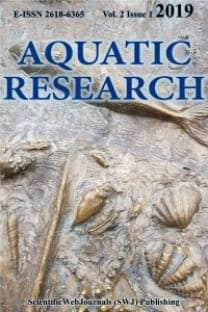GENETIC DIVERSITY OF THE ENDEMIC SPECIES SHABBOUT (Arabibarbus grypus (HECKEL, 1843)) BASED ON PARTIAL CYTOCHROME B SEQUENCES OF MITOCHONDRIAL DNA
Arabibarbus grypus (Heckel, 1843), a species endemic in river systems of Euphrates and Tigris, is an economically important freshwater fish. In this study, the genetic diversity of Arabibarbus grypus populations was determined basen on partial cytochrome b gene sequence of mtDNA. Totally 31 samples were collected from four localities and five polymorphic sites and five haplotypes were identified by carrying out mtDNA analysis. Mean haplotype (Hd) and nucleotide diversity (π) were calculated to be 0.348 and 0.00144 respectively. All values obtained following neutrality tests were found to be negative and statistically insignificant. Median joining network revealed that haplotype H1 was at the center of the network and was dominant. In the current survey, certain haplotypes (H2, H4, H5) identified for mtDNA cytochrome b gene are the new results to the literature and presented a novel data set for genetic diversity of this species.
___
Abdoli, A. (2000). The inlandwater fishes of Iran. Iranian Museum of Nature and Wildlife, Tehran. 378p. ISBN: 964-6902-01-4Asefi, M., Zamani-Ahmadmahmoodi, R. (2015). Mercury concentrations and health risk assessment for two fish species, Barbus grypus and Barbus luteus, from the Maroon River, Khuzestan Province, Iran. Environmental Monitoring and Assessment, 187, 653.
Avise, J. (1998). Phylogeography. Cambridge: MA. Harvard University Press., 102 pp. ISBN: 9780674666382 Briolay, J., Nicols Galtier, N., Brito, R. M., Bouvet, Y. (1998). Molecular Phylogeny of Cyprinidae Inferred from cytochrome b DNA Sequences. Molecular Phylogenetics and Evolution, 9(1), 100-108.
Dogu, Z., Aral, F. Sahinoz, E. (2014). The determination of some spermatological and hematological parameters of shabbout (Barbus grypus) in Atatürk Dam Lake, Sanliurfa. Journal of FisheriesSciences.com, 8(4), 265- 277.
Dusukcan, M., Calta M., Eroglu, M. (2015). Keban Baraj Gölü’nde Yaşayan Barbus grypus Heckel, 1843’de Otolit Biyometrisi-Balık Boyu İlişkisi. Yunus Araştırma Bülteni, 3, 21-29.
Fayazi, J., Moradi, M., Rahimi, G., Ashtyani, R., Galledari, H. (2006). Genetic differentiation and phylogenetic relationships among Barbus xanthopterus (Cyprinidae) populations in south west of Iran using mitochondrial DNA markers. Pakistan Journal of Biological Science, 9, 2249-54.
Gokcinar, N.C. (2010). Effect of partially replacing fishmeal with azolla (Azolla sp.) on growht parametres of shabbout fish (Tor grypus H. 1843). MSc thesis, Ankara University, Turkey. 51p.
Kaya, C. (2012). The fish fauna of the upper basin of the Tigris River, MSc thesis, Recep Tayyip Erdoğan University, Turkey. 156p.
Khodadadi, M., Arab, A., Jaferian, A. (2016). A Preliminary Study on Sperm Morphology, Motility and Composition of Seminal Plasma of Shirbot, Barbus grypus. Turkish Journal of Fisheries and Aquatic Sciences, 16, 947-951.
Liu, G., Zhou, L. (2016). Population genetic structure and molecular diversity of the red swamp crayfish in China based on mtDNA COI gene sequences, Mitochondrial DNA Part A, 28 (6), 860–866.
Mohammadian T., Alishahi, M., Tabandeh, M.R., Ghorbanpoor, M., Gharibi, D., Tollabi, M., Rohanizade, S. (2016). Probiotic effects of Lactobacillus plantarum and L. delbrueckii ssp. bulguricus on some immune-related parameters in Barbus grypus. Aquaculture International, 24, 225-242.
Nei, M. (1987). Molecular evolutionary genetics. New York: Columbia University Press., 512 pp. ISBN: 9780231063210
Nikpei, M. (1996). Research project report: biological study of Barbus grypus and Barbus sharpie. Iranian Fisheries Research Institute, 1, 52-64.
Oymak, S. A., Dogan, N., Uysal, E. (2008). Age, growth and reproduction of the Shabut Tor grypus (Cyprinidae) in Ataturk Dam Lake (Euphrates River), Turkey. Cybium, 32, 2, 145-152.
Oymak, S. A., Karadede, H., Dogan, N. (2009). Heavy metal in tissues of Tor grypus from Ataturk Dam Lake, Euphrates River-Turkey, Biologia, 64, 1, 151-155.
Parmaksız, A., Ates, B., Toprak, S. (2016). Investigation of usefulness of DNA Microsatellite markers in some carp species. Harran Üniversitesi Veteriner Fakültesi Dergisi, 5(1), 1-4.
Parmaksiz, A., Seker, O., Aslan, N., Oymak, A. (2017). Determination of Genetic Diversity in Barbus grypus Heckel, 1843 Populations by mtDNA COI Gene Sequences. Yunus Araştırma Bülteni, 1, 103-107.
Parmaksız, A., Eksi, E. (2017). Genetic diversity of the cyprinid fish Capoeta trutta (Heckel, 1843) populations from Euphrates and Tigris rivers in Turkey based on mtDNA COI sequences. Indian Journal of Fisheries, 64(1), 18-22.
Rozas, J., Sanchez- DelBarrio, J. C., Messeguer, X. Rozas, R. (2003). DnaSP DNA polymorphism analyses by the coalescent and other methods. Bioinformatics, 19, 2496-2497.
Saraswat, D., Lakra, W.S., Nautiyal, P., Goswami, M., Shyamakant, K., Malakar, A. (2014). Genetic characterization of Clupisoma garua (Hamilton 1822) from six Indian populations using mtDNA cytochrome b gene. Mitochondrial DNA, 25(1), 70-77.
Xu, Z.H., Chen, J.L., Cheng, D.F., Liu, Y., Eric, F. (2011). Genetic variation among the geographic population of the Grain Aphid, Sitobion avenae (Hemiptera: Aphididae) in China inferred from mitochondrial COI gene sequence. Agricultural Sciences in China, 10, 1041-1048.
- ISSN: 2618-6365
- Yayın Aralığı: 4
- Başlangıç: 2018
- Yayıncı: Nuray ERKAN ÖZDEN
